Post by TasunkaWitko on Feb 29, 2012 1:42:19 GMT -5
Bogrács Gulyás
My friends, everything you have been told is a lie.
That hamburger-macaroni-tomato concoction that the lunch lady gave you wasn't "real" goulash, nor was the similar mess served at the church potluck supper, or the reddish, brownish, yellowish looking stuff plopped on your plate by your Aunt Doris on the days when you went to visit. It was all a fabrication; a bastardised, Americanised myth propagated by culprits such as Betty Crocker, Margaret Fulton and a fellow named Campbell....
Or was it?
Andy (Boilermaker) covered the history of gulyás (also known throughout the world as gulasch, goulash, guláš and a few other similar names) very well in his post:
foodsoftheworld.activeboards.net/bogracs-gulyas-from-the-cooking-of-viennas-empire_topic755.html
My post will take a look at the question, "What makes gulyás, gulyás?
Wikipedia gives us a baseline, citing the Hungarian origins of the dish:
From there, some history of the dish is discussed, followed by an enumeration of the regional varieties in central, eastern and southern Europe, including the countries mentioned above. Basically, this regional distribution corresponds with the borders of the Austro-Hungarian Empire, plus or minus a few kingdoms or principalities. All versions are basically similar, with a few differences based on local tastes, customs or availability of ingredients.
And just what are the ingredients? Well, for meat, beef, veal, pork, lamb, mutton, venison and wild boar are mentioned; sometimes smoked, sometimes in the form of a sausage. Sometimes browned or seared, and sometimes not. The thing that most of the meats have in common are that they come from the tough, flavorful cuts of the animal. Onions are the next most-prominent ingredient, cooked in fat, most typically lard, in order to bring out all the good flavours. There's also a starch involved, which could be potatoes, dumplings, noodles, kasha, pasta or, in some cases rice. Various vegetables can also be added, including, sometimes, peppers and/or tomatoes, neither of which should ever take over the dish, if used. Carrots, celery, parsnips, mushrooms, beans and even sauerkraut, to name just a few, can also be found in various forms of gulyás. And the spices - there can be so many! Aside from the usual salt and pepper, the one spice that all forms of gulyás have in common is paprika, which is featured prominently and forms a major flavour profile of the dish; one can also find find garlic, caraway seed, herbs such as bay leaf, marjoram or thyme, as well as many others. Beyond that, wine, vinegar, beer or even lemon juice can be added to some versions, for a little extra piquant depth. One Hungarian variety even features sour cream.
This ingredients list is hardly exhaustive, and to the casual reader, it would seem that the possibilities are endless and that gulyás/goulash could be made from just about anything; indeed, the Czech word, guláš, is a slang term for "mishmash."
Moving across the pond from there, Wiki gives us some interesting information:
So, looking at it from that viewpoint, maybe that stuff you remember as a kid was indeed goulash!
But getting back to Hungary, and traditional Hungarian gulyás, here is a fairly typical recipe for that was customarily cooked by cattle drovers in an iron kettle over an open fire. From Time/Life's Foods of the World - The Cooking of Vienna's Empire, 1968:
So let's get started! First, as always, is a shot of the goods as according to the recipe above:
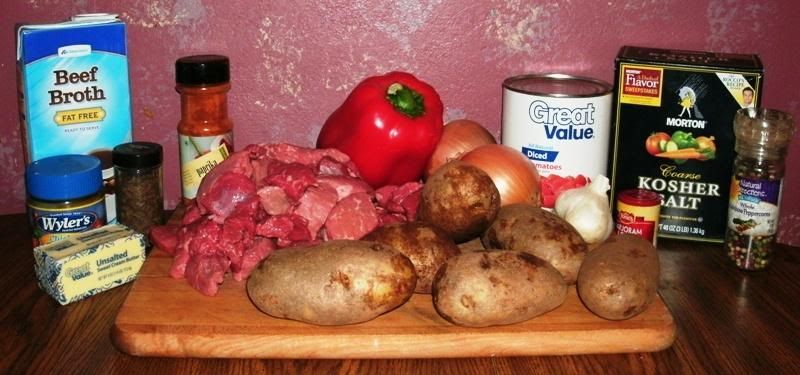
I had considered ommiting the caraway seeds, due to the fact that the beautiful Mrs. Tas does not like them; however, the proscribed amount is very small, so I ultimately decided to use them in order to get into the traditional spirit of things. I did, however, hold fast to my "no green peppers" policy, substituting a good-sized red one. For the beef, I used just over 4 pounds of cheap, flavourful "stew meat," so the photo above represents what is essentially a double recipe.
One of the age-old controversies when making gulyás is whether or not to sear the meat during preparation. If the meat is in fact seared, it is generally accepted that it should not be dredged in flour, since thickening gulyás with a roux or flour simply isn't done, at least in most cases. For this preparation, I decided to sear the beef in my cast iron Dutch oven, and set about doing so:
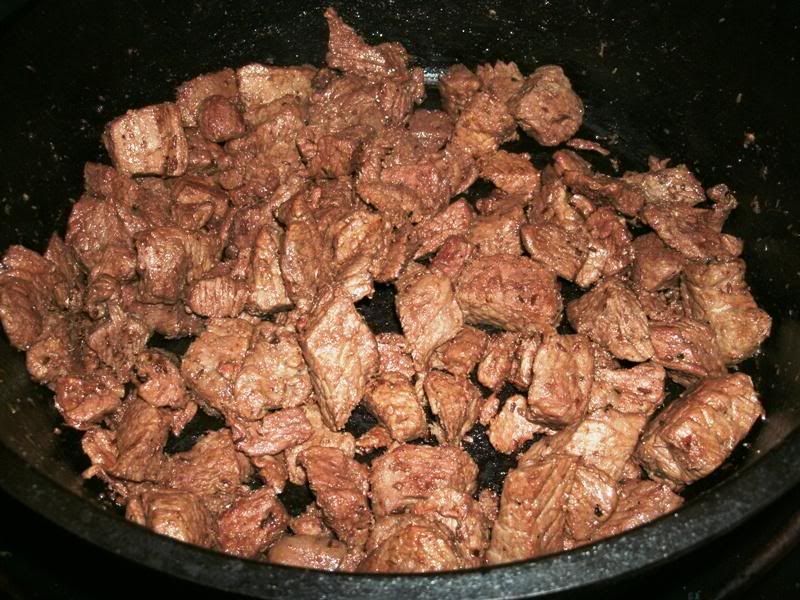
More on the effects of that action later.
Traditionally, lard is used when making gulyás; however, since I had none on hand, I used a little butter for this step. After the beef was seared, I added an additional tablespoon of butter and cooked the chopped onions over medium heat for a few minutes, until they just started to turn brown and carmelise. Then I removed the Dutch oven from the heat and added the garlic and paprika to the onions, stirring them as the rich, red spice released its oils and darkened:

I then added the beef back to the Dutch oven, along with the broth, caraway seeds, salt and pepper:
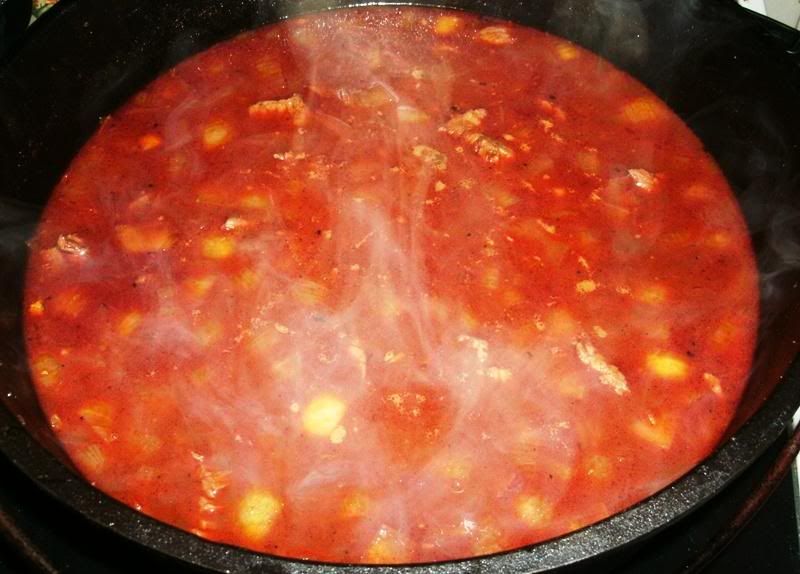
I brought this to a boil, then reduced the heat and simmered gently, keeping the lid only partially on so that some evaporation could take place and allow the gulyás to thicken up just a bit. After an hour, here's what I saw:
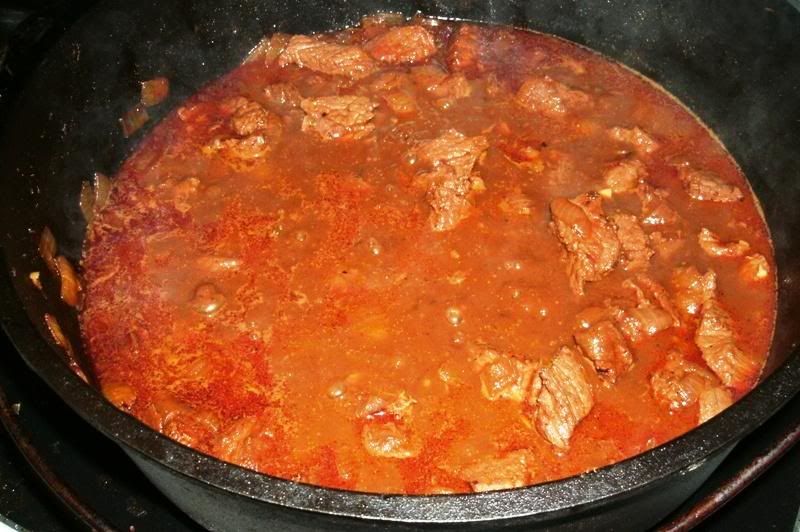
Next, I added the potatoes, tomatoes, chopped red pepper and marjoram:
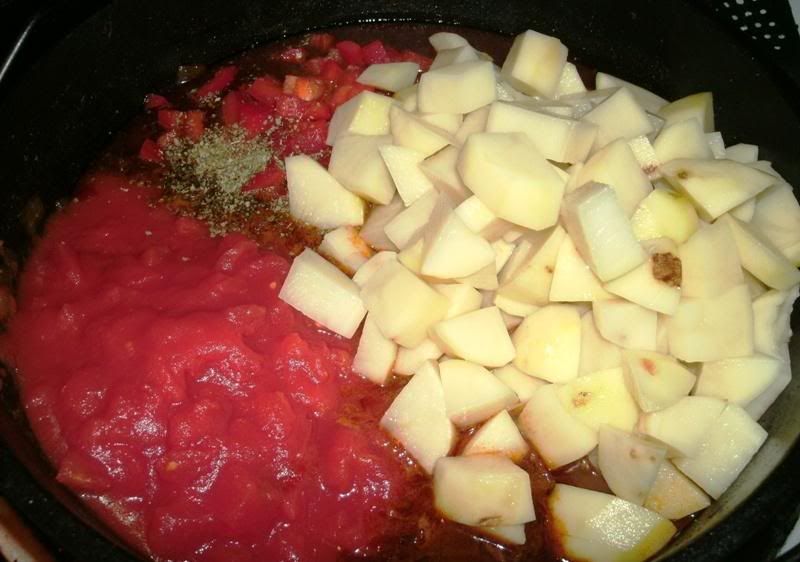
The recipe advised parboiling the potatoes first, but I elected not to do this; as far as I can tell, the finished meal did not suffer from it.
The gulyás was really starting to look good:
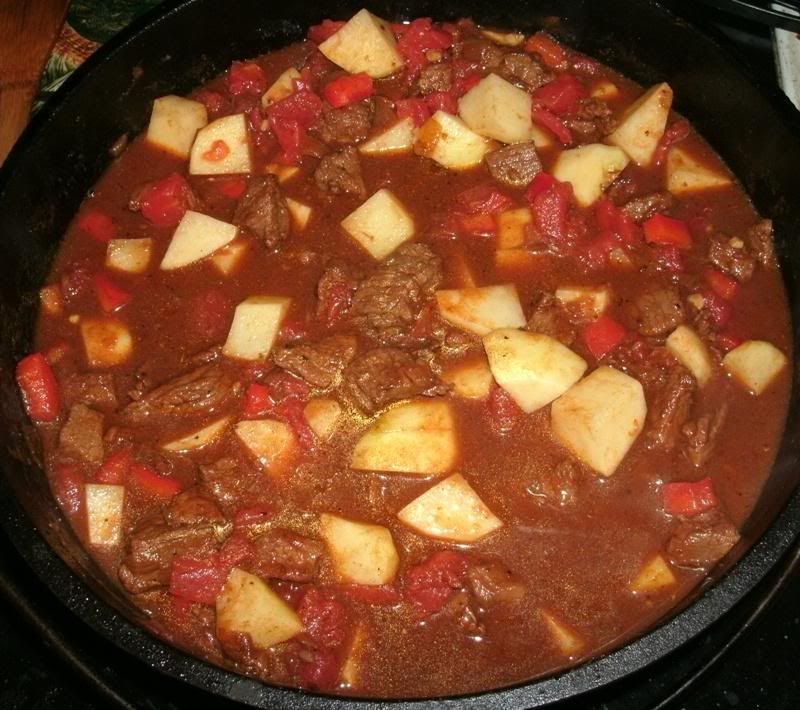
I had expected the gulyás to be much more reddish than it was; it appears that searing the beef beforehand results in a darker end product, due of course to the browning of the meat:
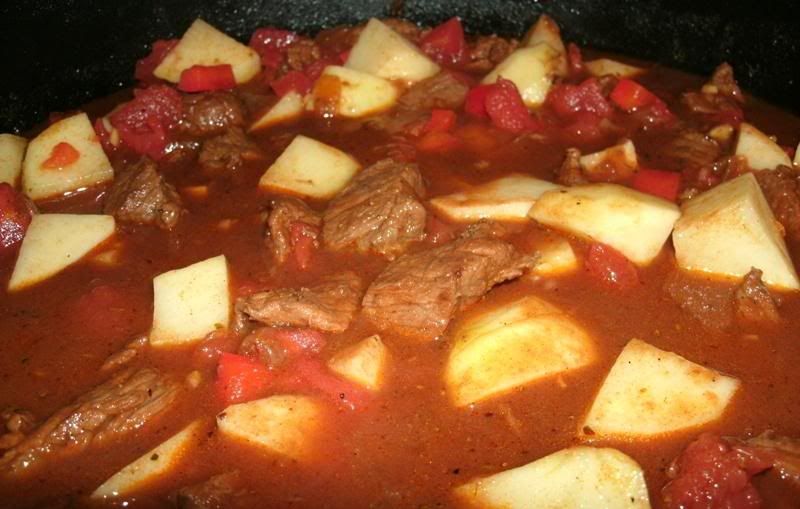
I then simmered the gulyás for another 45 minutes or so, partially covered, to cook the potatoes throughout and allow the beef to become fork-tender. Doring this time, the modest reduction brought on by evaporation allowed the gulyás to thicken and become even richer. But it wasn't much longer before the wonderful aroma and the delicious-looking gulyás could be ignored no more:
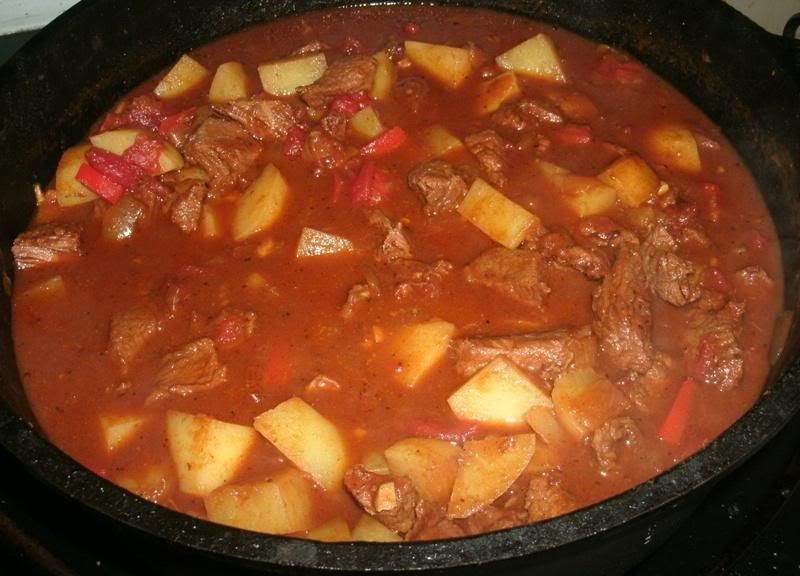
The gulyás was done, there was no reason to wait, so I served it along with some really nice beer bread that I baked earlier that day:

One taste was enough to convince me that this was NOT the goulash that was served by the lunch lady. This was rich, savory, satisfying gulyás, and trust me when I say that there is a difference:
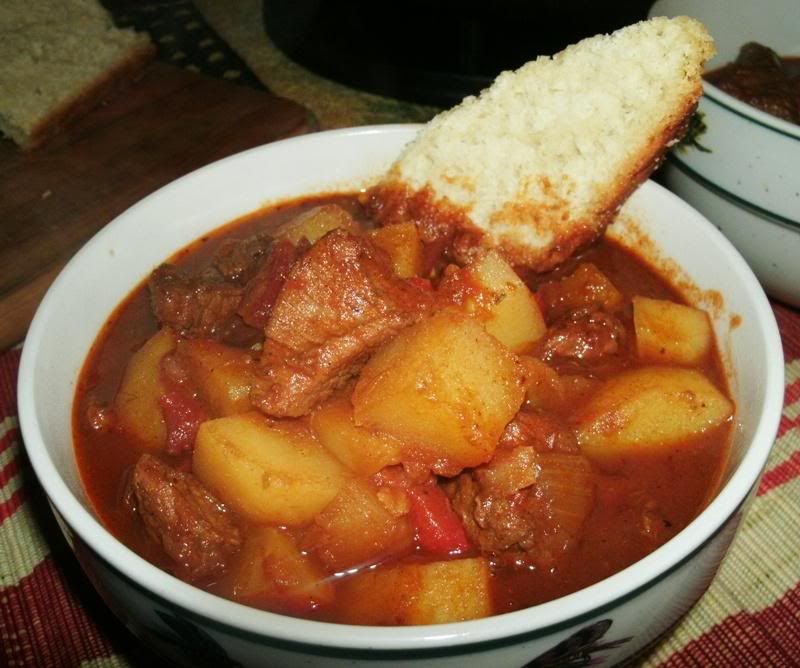
The tender chunks of potato carried the humble, yet noble flavours straight into orbit, accented just slightly by the tomatoes, marjoram, and even the hint of caraway and peppers that I had been so worried about. Interlaced through it all, the warm, dark paprika wrapped itself around me, taking me across the ocean to the verdant Hungarian plains. It wasn't at all difficult to imagine myself enjoying this humble, timeless meal under the stars as the cattle settled down for the evening, lowing their soft lullabyes to their calves.
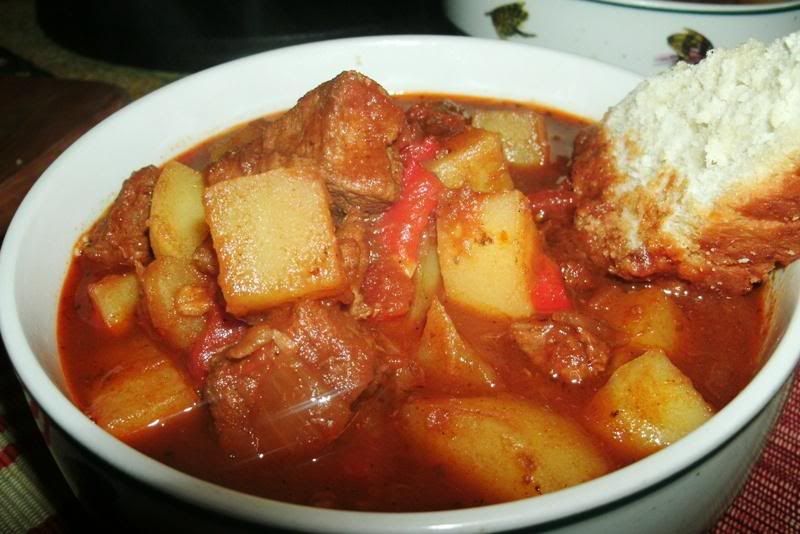
My friends, this stuff is the real deal, and I can assure you, it will be a hit in your home. If you like beef, onions and tradition, you're going to love this.
My friends, everything you have been told is a lie.
That hamburger-macaroni-tomato concoction that the lunch lady gave you wasn't "real" goulash, nor was the similar mess served at the church potluck supper, or the reddish, brownish, yellowish looking stuff plopped on your plate by your Aunt Doris on the days when you went to visit. It was all a fabrication; a bastardised, Americanised myth propagated by culprits such as Betty Crocker, Margaret Fulton and a fellow named Campbell....
Or was it?
Andy (Boilermaker) covered the history of gulyás (also known throughout the world as gulasch, goulash, guláš and a few other similar names) very well in his post:
foodsoftheworld.activeboards.net/bogracs-gulyas-from-the-cooking-of-viennas-empire_topic755.html
My post will take a look at the question, "What makes gulyás, gulyás?
Wikipedia gives us a baseline, citing the Hungarian origins of the dish:
[Gulyás] is a soup or stew of meat...and vegetables (especially potato), seasoned with paprika and other spices. Originating in Hungary, goulash is also a popular meal in Austria, Bosnia & Herzegovina, Croatia, Czech Republic, Germany, Poland, Romania, Scandinavia, Serbia, Slovakia, Slovenia and some regions of Italy. It is one of Hungary's national dishes.
From there, some history of the dish is discussed, followed by an enumeration of the regional varieties in central, eastern and southern Europe, including the countries mentioned above. Basically, this regional distribution corresponds with the borders of the Austro-Hungarian Empire, plus or minus a few kingdoms or principalities. All versions are basically similar, with a few differences based on local tastes, customs or availability of ingredients.
And just what are the ingredients? Well, for meat, beef, veal, pork, lamb, mutton, venison and wild boar are mentioned; sometimes smoked, sometimes in the form of a sausage. Sometimes browned or seared, and sometimes not. The thing that most of the meats have in common are that they come from the tough, flavorful cuts of the animal. Onions are the next most-prominent ingredient, cooked in fat, most typically lard, in order to bring out all the good flavours. There's also a starch involved, which could be potatoes, dumplings, noodles, kasha, pasta or, in some cases rice. Various vegetables can also be added, including, sometimes, peppers and/or tomatoes, neither of which should ever take over the dish, if used. Carrots, celery, parsnips, mushrooms, beans and even sauerkraut, to name just a few, can also be found in various forms of gulyás. And the spices - there can be so many! Aside from the usual salt and pepper, the one spice that all forms of gulyás have in common is paprika, which is featured prominently and forms a major flavour profile of the dish; one can also find find garlic, caraway seed, herbs such as bay leaf, marjoram or thyme, as well as many others. Beyond that, wine, vinegar, beer or even lemon juice can be added to some versions, for a little extra piquant depth. One Hungarian variety even features sour cream.
This ingredients list is hardly exhaustive, and to the casual reader, it would seem that the possibilities are endless and that gulyás/goulash could be made from just about anything; indeed, the Czech word, guláš, is a slang term for "mishmash."
Moving across the pond from there, Wiki gives us some interesting information:
In Australia, Canada and the United States, various adaptations have made the dish more suitable for local preferences. Minced beef frequently replaces cut beef in the recipe, which reduces the cost as well as the cooking time. The meat and onions are then placed in the pan, the other ingredients are added and the dish might be ready to serve in as little time as 20 to 30 minutes. This goulash is commonly finished by the addition of noodles, pasta, or elbow macaroni. This form of the dish was made popular by its inclusion in popular cookbooks in the early and mid twentieth century, such as Betty Crocker's Cookbook and the Margaret Fulton Cookbook.
Goulash is also a slang term in some parts of the United States, particularly the South, for a dish made with miscellaneous left-overs. Noodles or potatoes are usually added thereafter. In parts of New England and the Midwest, Goulash can refer to a pasta dish with ground beef and tomato sauce, also known as American Chop Suey.
Goulash is also a slang term in some parts of the United States, particularly the South, for a dish made with miscellaneous left-overs. Noodles or potatoes are usually added thereafter. In parts of New England and the Midwest, Goulash can refer to a pasta dish with ground beef and tomato sauce, also known as American Chop Suey.
So, looking at it from that viewpoint, maybe that stuff you remember as a kid was indeed goulash!
But getting back to Hungary, and traditional Hungarian gulyás, here is a fairly typical recipe for that was customarily cooked by cattle drovers in an iron kettle over an open fire. From Time/Life's Foods of the World - The Cooking of Vienna's Empire, 1968:
To serve 4-6:
2 tablespoons lard
1 cup finely chopped onions
1/2 teaspoon finely chopped garlic
3 tablespoons sweet Hungarian paprika
2 pounds shin beef, cut into 1.5-inch cubes
1/2 teaspoon caraway seeds
4 cups chicken or beef stock (or mixed chicken and beef stock), fresh or canned. or 4 cups water
Freshly-ground black pepper
2 medium-sized boiling potatoes
1 pound tomatoes, peeled, seeded and finely chopped (about 1.5 cups)
2 medium-sized green peppers, with seeds and ribs removed, finely chopped
1/2 teaspoon marjoram
Heat the lard in a 4- or 5-quart heavy saucepan until a light haze forms over it, then reduce the heat to medium and add the onions and garlic. Cook them 8 to 10 minutes or until the onions are lightly coloured. Off the heat, stir in the paprika. Stir until the onions are well-coated.
Add the beef cubes, caraway seeds and stock or water to the pan and season with the salt and pepper. Bring the liquid to a boil and partially cover the pan. Simmer for 1 hour, or until the beef is tender.
Parboil the potatoes in boiling water for 8 to 10 minutes, or until they can easily be penetrated with the point of a sharp knife for 1/4 inch or so. Peel them, cut them into 1.5-inch cubes and add them, the tomatoes, the peppers and marjoram to the pan. Partially cover again and cook over medium heat for 25 to 35 minutes, or until the potatoes are done and beef is tender. Skim off any surface fat and taste for seasoning.
Serve the gulyás in deep, individual plates.
2 tablespoons lard
1 cup finely chopped onions
1/2 teaspoon finely chopped garlic
3 tablespoons sweet Hungarian paprika
2 pounds shin beef, cut into 1.5-inch cubes
1/2 teaspoon caraway seeds
4 cups chicken or beef stock (or mixed chicken and beef stock), fresh or canned. or 4 cups water
Freshly-ground black pepper
2 medium-sized boiling potatoes
1 pound tomatoes, peeled, seeded and finely chopped (about 1.5 cups)
2 medium-sized green peppers, with seeds and ribs removed, finely chopped
1/2 teaspoon marjoram
Heat the lard in a 4- or 5-quart heavy saucepan until a light haze forms over it, then reduce the heat to medium and add the onions and garlic. Cook them 8 to 10 minutes or until the onions are lightly coloured. Off the heat, stir in the paprika. Stir until the onions are well-coated.
Add the beef cubes, caraway seeds and stock or water to the pan and season with the salt and pepper. Bring the liquid to a boil and partially cover the pan. Simmer for 1 hour, or until the beef is tender.
Parboil the potatoes in boiling water for 8 to 10 minutes, or until they can easily be penetrated with the point of a sharp knife for 1/4 inch or so. Peel them, cut them into 1.5-inch cubes and add them, the tomatoes, the peppers and marjoram to the pan. Partially cover again and cook over medium heat for 25 to 35 minutes, or until the potatoes are done and beef is tender. Skim off any surface fat and taste for seasoning.
Serve the gulyás in deep, individual plates.
So let's get started! First, as always, is a shot of the goods as according to the recipe above:

I had considered ommiting the caraway seeds, due to the fact that the beautiful Mrs. Tas does not like them; however, the proscribed amount is very small, so I ultimately decided to use them in order to get into the traditional spirit of things. I did, however, hold fast to my "no green peppers" policy, substituting a good-sized red one. For the beef, I used just over 4 pounds of cheap, flavourful "stew meat," so the photo above represents what is essentially a double recipe.
One of the age-old controversies when making gulyás is whether or not to sear the meat during preparation. If the meat is in fact seared, it is generally accepted that it should not be dredged in flour, since thickening gulyás with a roux or flour simply isn't done, at least in most cases. For this preparation, I decided to sear the beef in my cast iron Dutch oven, and set about doing so:

More on the effects of that action later.
Traditionally, lard is used when making gulyás; however, since I had none on hand, I used a little butter for this step. After the beef was seared, I added an additional tablespoon of butter and cooked the chopped onions over medium heat for a few minutes, until they just started to turn brown and carmelise. Then I removed the Dutch oven from the heat and added the garlic and paprika to the onions, stirring them as the rich, red spice released its oils and darkened:

I then added the beef back to the Dutch oven, along with the broth, caraway seeds, salt and pepper:

I brought this to a boil, then reduced the heat and simmered gently, keeping the lid only partially on so that some evaporation could take place and allow the gulyás to thicken up just a bit. After an hour, here's what I saw:

Next, I added the potatoes, tomatoes, chopped red pepper and marjoram:

The recipe advised parboiling the potatoes first, but I elected not to do this; as far as I can tell, the finished meal did not suffer from it.
The gulyás was really starting to look good:

I had expected the gulyás to be much more reddish than it was; it appears that searing the beef beforehand results in a darker end product, due of course to the browning of the meat:

I then simmered the gulyás for another 45 minutes or so, partially covered, to cook the potatoes throughout and allow the beef to become fork-tender. Doring this time, the modest reduction brought on by evaporation allowed the gulyás to thicken and become even richer. But it wasn't much longer before the wonderful aroma and the delicious-looking gulyás could be ignored no more:

The gulyás was done, there was no reason to wait, so I served it along with some really nice beer bread that I baked earlier that day:

One taste was enough to convince me that this was NOT the goulash that was served by the lunch lady. This was rich, savory, satisfying gulyás, and trust me when I say that there is a difference:

The tender chunks of potato carried the humble, yet noble flavours straight into orbit, accented just slightly by the tomatoes, marjoram, and even the hint of caraway and peppers that I had been so worried about. Interlaced through it all, the warm, dark paprika wrapped itself around me, taking me across the ocean to the verdant Hungarian plains. It wasn't at all difficult to imagine myself enjoying this humble, timeless meal under the stars as the cattle settled down for the evening, lowing their soft lullabyes to their calves.

My friends, this stuff is the real deal, and I can assure you, it will be a hit in your home. If you like beef, onions and tradition, you're going to love this.





